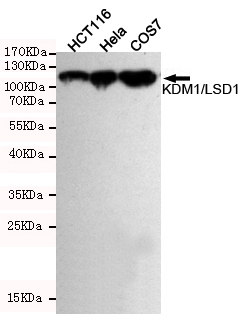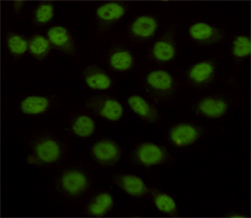KDM1/LSD1 mouse mAb
- Catalog No.:YM1203
- Applications:WB;ICC;IP
- Reactivity:Human;Monkey
- Target:
- KDM1/LSD1
- Fields:
- >>Thermogenesis
- Gene Name:
- kdm1a
- Human Gene Id:
- 23028
- Human Swiss Prot No:
- O60341
- Mouse Swiss Prot No:
- Q6ZQ88
- Immunogen:
- Purified recombinant human KDM1/LSD1 protein fragments expressed in E.coli.
- Specificity:
- This antibody detects endogenous levels of KDM1/LSD1 and does not cross-react with related proteins.
- Formulation:
- Liquid in PBS containing 50% glycerol, 0.5% BSA and 0.02% sodium azide.
- Source:
- Monoclonal, Mouse
- Dilution:
- wb 1:1000 icc 1:100
- Purification:
- The antibody was affinity-purified from mouse ascites by affinity-chromatography using epitope-specific immunogen.
- Concentration:
- 1 mg/ml
- Storage Stability:
- -15°C to -25°C/1 year(Do not lower than -25°C)
- Other Name:
- Amine oxidase (flavin containing) domain 2;AOF2;BHC110;BRAF35 HDAC complex protein BHC110;BRAF35-HDAC complex protein BHC110;FAD binding protein BRAF35 HDAC complex, 110 kDa subunit;Flavin-containing amine oxidase domain-containing protein 2;KDM 1;KDM1;Kdm1a;KDM1A_HUMAN;LSD 1;LSD1;Lysine (K) specific demethylase 1;Lysine (K) specific demethylase 1A;Lysine specific histone demethylase 1;Lysine specific histone demethylase 1A;Lysine-specific histone demethylase 1A.
- Observed Band(KD):
- 110kD
- Background:
- This gene encodes a nuclear protein containing a SWIRM domain, a FAD-binding motif, and an amine oxidase domain. This protein is a component of several histone deacetylase complexes, though it silences genes by functioning as a histone demethylase. Alternative splicing results in multiple transcript variants. [provided by RefSeq, Apr 2009],
- Function:
- cofactor:FAD.,domain:The SWIRN domain may act as an anchor site for a histone tail.,function:Histone demethylase that demethylates 'Lys-4' of histone H3, a specific tag for epigenetic transcriptional activation, thereby acting as a corepressor. Acts by oxidizing the substrate by FAD to generate the corresponding imine that is subsequently hydrolyzed. Demethylates both mono- and di-methylated 'Lys-4' of histone H3. May play a role in the repression of neuronal genes. Alone, it is unable to demethylate H3 'Lys-4' on nucleosomes and requires the presence of RCOR1/CoREST to achieve such activity. May also demethylate 'Lys-9' of histone H3, a specific tag for epigenetic transcriptional repression, thereby leading to derepression of androgen receptor target genes. Demethylates di-methylated 'Lys-370' of p53/TP53 which prevents interaction of p53/TP53 with TP53BP1 and represses p53/TP53-mediate
- Subcellular Location:
- Nucleus .
- Expression:
- Ubiquitously expressed.
- June 19-2018
- WESTERN IMMUNOBLOTTING PROTOCOL
- June 19-2018
- IMMUNOHISTOCHEMISTRY-PARAFFIN PROTOCOL
- June 19-2018
- IMMUNOFLUORESCENCE PROTOCOL
- September 08-2020
- FLOW-CYTOMEYRT-PROTOCOL
- May 20-2022
- Cell-Based ELISA│解您多样本WB检测之困扰
- July 13-2018
- CELL-BASED-ELISA-PROTOCOL-FOR-ACETYL-PROTEIN
- July 13-2018
- CELL-BASED-ELISA-PROTOCOL-FOR-PHOSPHO-PROTEIN
- July 13-2018
- Antibody-FAQs
- Products Images

- Western blot detection of KDM1/LSD1 in Hela,HCT116 and COS7 cell lysates using KDM1/LSD1 mouse mAb (1:1000 diluted).Predicted band size:110KDa.Observed band size:110KDa.

- Immunocytochemistry staining of HeLa cells fixed with 4% Paraformaldehyde and using anti-KDM1/LSD1 mouse mAb (dilution 1:100).

- Immunoprecipitation analysis of Hela cell lysates using KDM1/LSD1 mouse mAb.



